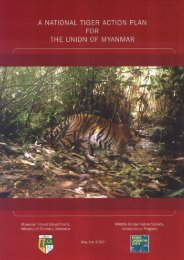Download - Global Tiger Initiative
Download - Global Tiger Initiative
Download - Global Tiger Initiative
Create successful ePaper yourself
Turn your PDF publications into a flip-book with our unique Google optimized e-Paper software.
and human encroachment, which have led to increased fragmentation of populations, and<br />
possibly to isolation of western populations from those in the east.<br />
Between 150 and 200 Snow Leopards are estimated to live in the Russian Federation, according<br />
to comprehensive surveys undertaken in 2000 and 2001 (Poyarkov and Subbotin, 2002).<br />
Tajikistan<br />
In Tajikistan, Snow Leopards are found in the mountains in the east of the country, the main<br />
population occurring in the Pamir region, in isolated patches of relatively good habitat<br />
(Buzurukov and Muratov, 1994). Snow Leopards in Tajikistan are listed in the Red Data Book 3 ,<br />
as ‘rare’ (Abdusaliamov, 1988). Little is known about the current status of the Snow Leopard<br />
in Tajikistan, but populations are thought to be in decline. In 1990, Sokov estimated the total<br />
population of Snow Leopards in Tajikistan at around 200-300 animals, but this figure has been<br />
considered an over-estimate and others put the total population at 80-100 or 120-300 animals<br />
(Buzurukov and Muratov, 1994). A more recent population estimate for Tajikistan suggests that<br />
the total population is around 180-220 animals (E. Bykova, B. Grebot and E. Kreuzberg-<br />
Mukhina, Institute of Zoology, Uzbekistan and London Imperial College, UK, in litt., 2002.).<br />
Uzbekistan<br />
Snow Leopards are known to occur in the eastern parts of Uzbekistan, in the mountains<br />
bordering Kyrgyzstan and Tajikistan, where they have been reported from the Turkestanskiy,<br />
Chatkalskiy and Gissarskiy ranges. The number of Snow Leopards in Uzbekistan is estimated<br />
to be no more than 20-50 (Kreuzberg-Mukhina et al., 2002).<br />
LEGAL STATUS AND REGULATION<br />
At international level<br />
CITES<br />
Snow Leopards have been included in Appendix I of CITES since 1975 and hence all international<br />
commercial trade in the species, its parts and derivatives is prohibited in those countries<br />
which are Parties to this Convention. This includes all Snow Leopard range States apart from<br />
Kyrgyzstan and Tajikistan, although some range States joined the Convention only recently and<br />
in others CITES is not fully implemented (see Table 2). Afghanistan, for example, which joined<br />
CITES in 1986, has yet to submit an annual report.<br />
Other provisions of CITES relate to Snow Leopards, notably the following, adopted at the<br />
twelfth meeting of the Conference of the Parties to CITES, in November 2002:<br />
•<br />
Resolution Conf. Res. 12.5 on the Conservation of and trade in <strong>Tiger</strong>s and other Appendix-I<br />
Asian big cat species. This Resolution of the CITES Parties formally recognizes that all<br />
Asian big cats are threatened by illegal use and trade. It calls upon CITES Parties to<br />
improve efforts to combat the illegal killing of, and trade in, Asian big cats, at national,<br />
regional and international levels.<br />
FADING FOOTPRINTS: the killing and trade of Snow Leopards 11

















